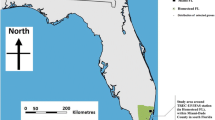Abstract
Larvae of Deliaradicum Linnaeus (Diptera: Anthomyiidae) wereexposed to Steinernema feltiae Filipjev(Rhabditida) to study the ability of thenematodes to fulfill their life cycle (recycle)in this host. In addition, the recycling ofSteinernema and Heterorhabditis(Rhabditida) species was studied in larvae ofthe following insects: Meligethes spp.Stephens (Coleoptera: Nitidulidae),Dasyneura brassicae Winnertz (Diptera:Cecidomyidae), Ceutorrhynchus assimilisPaykull, C. pallidactylus Marsham (Coleoptera: Curculionidae) and Mamestrabrassicae Linnaeus (Lepidoptera: Noctuidae).All larval instars of D. radicum werestudied (larvae live and pupate in soil)whereas the final instars of the remaininginsects were studied (larvae only pupate in soil).On average, the following numbers of infectivejuveniles were produced in the different hosts:1,200–1,400 in C. assimilis; 700–1,300 inMeligethes spp. and 47,000 in M.brassicae. In D. radicum, around 400infective juveniles were produced on average inthe smallest larvae and around 3,500 in thelargest larvae. The highest number of nematodesrecorded in a D. radicum larva (thirdinstar) was 9,500 infective juveniles. Thenumber of nematodes produced in D.radicum cadavers was positively related to thesize of the insect host, but large variationwas observed.
Similar content being viewed by others
References
Battisti, A., 1994. Effects of entomopathogenic nematodes on the spruce web-spinning sawfly Cephalcia arvensis Panzer and its parasitoids in the field. Biocont. Sci. Tech. 4: 95–102.
Boag, B., R. Neilson and S.C. Gordon, 1992. Distribution and prevalence of the entomopathogenic nematode Steinernema feltiae in Scotland. Ann. Appl. Biol. 121: 355–360.
Bracken, G.K., 1990. Susceptibility of first-instar cabbage maggot, Delia radicum (L.) (Anthomyiidae: Diptera), to strains of the entomogenous nematodes Steinernema feltiae Filipjev, S. bibionis (Bovien), Heterorhabditis bacteriophora Poinar, and H. heliothidis (Khan, Brooks and Hirschmann). Can. Entomol. 122: 633–639.
Epsky, N.D. and J.L. Capinera, 1994. Influence of herbivore diet on the pathogenesis of Steinernema carpocapsae (Nematoda: Steinernematidae). Environ. Entomol. 23: 487–491.
Gaugler, R. (ed), 2002. Entomopathogenic Nematology. CABI Publisher, New York. 388 pp.
Gouge, D.H. and N.G.M. Hague, 1995. The development of Steinernema feltiae (Nematoda: Steinernematidae) in the sciarid fly Bradysia paupera (Diptera: Sciaridae). Ann. Appl. Biol. 126: 395–401.
Georgis, R. and G.M. Hague, 1988. Field evaluation of Steinernema feltiae against the webspinning larch sawfly Cephalcia lariciphila. J. Nem. 20: 317–320.
Hatab, M.A., R. Gaugler and R.U. Ehlers,1998. Influence of culture method on Steinernema glaseri lipids. J. Parasit. 84, 215–221.
Jaworska, M., 1993. The effect of entomopathogenic nematodes from the families of the Heterorhabditidae and Steinernematidae on Delia brassicae Hoffmannsegg (Diptera, Anthomyiidae) and its natural enemies. Polskie Pismo Entomol. 62: 243–254.
Jaworska, M. and D. Ropek, 1994. Influence of host-plant on the susceptibility of Sitona lineatus L. (Col., Curculionidae) to Steinernema carpocapsae Weiser. J. Invertebr. Pathol. 64: 96–99.
Jaworska, M. and K. Wiech, 1988. Susceptibility of the clover root weevil, Sitona hispidulus F. (Col., Curculionidae) to Steinernema feltiae, St. bibionis, and Heterorhabditis bacteriophora. J. Appl. Entomol. 106: 372–376.
Kakouli-Duarte, T. and N.G.M. Hague, 1999. Infection, development, and reproduction of the entomopathogenic nematode Steinernema arenarium (Nematoda: Steinernematidae) in the black vine weevil Otiorhynchus sulcatus (Coleoptera: Curculionidae). Nematology 1: 149–156.
Klingler, J., 1988. Investigations on the parasitism of Otiorhynchus salicicola and O. sulcatus (Col.: Curculionidae) by Heterorhabditis sp. (Nematoda). Entomophaga 33: 325–331.
Mannion, C.M. and R.K. Jansson, 1992. Comparison of ten entomopathogenic nematodes for control of sweetpotato weevil (Coleoptera: Apionidae). J. Econ. Entomol. 85: 1642–1650.
Mráček, Z. and K. Spitzer, 1983. Interaction of the predators and parasitoids of the sawfly, Cephalcia abietis (Pamphilidae: Hymenoptera) with its nematode Steinernema kraussei. J. Invertebr. Pathol. 42: 397–399.
Nilsson, C. 1987. Yield losses in summer rape caused by pollen beetles (Meligethes spp.). Swed. J. Agric. Res. 17: 105–111.
Rogers, L.E., W.T. Hinds and R.L. Buschbom, 1977. A general weight vs. length relationship for insects. Ann. Entomol. Soc. America 69: 387–389.
Royer, L., G. Belair, G. Boivin and Y. Fournier, 1996. Attractiveness of cabbage maggot (Diptera: Anthomyiidae) to entomopathogenic steinernematid nematodes. J. Econ. Entomol. 89: 614–620.
Selvan, S., J.F. Campbell and R. Gaugler, 1993. Density-dependent effects on entomopathogenic nematodes (Heterorhabditidae and Steinernematidae) within an insect host. J. Invertebr. Pathol. 62: 278–284
Shanks, C.H.J. and F. Agudelo-Silva, 1990. Field pathogenicity and persistence of heterorhabditid and steinernematid nematodes (Nematoda) infecting black vine weevil larvae (Coleoptera: Curculionidae) in cranberry bogs. J. Econ. Entomol. 83: 107–110.
Stuart, R.J. and R. Gaugler, 1994. Patchiness in populations of entomopathogenic nematodes. J. Invertebr. Pathol. 64: 39–45.
Sturhan, D., 1996. Seasonal occurrence, horizontal and vertical dispersal of entomopathogenic nematodes in a field. Mitteil. Biol. Bundesanst. Land Forstwirtschaft Berlin Dahlem 317: 35–45.
Sulistyanto, D., A. Peters, H. Hokkanen and R.U. Ehlers, 1994. Evaluation of entomopathogenic nematode strains for control of Delia radicum, Tipula paludosa and T. oleracea. Bull. OILB SROP 17(3): 140–143.
Tomalak, M., 1994. Genetic improvement of Steinernema feltiae for integrated control of the western flower thrips, Frankliniella occidentalis. Bull. OILB SROP 17(3): 17–20.
van Sloun, P., 1989. Control of the cabbage root fly Delia radicum L. and the white-line dart moth, Agrotis segetum Schiff. with entomophagous nematodes of the genera Steinernematidae and Heterorhabditidae as well as the influence of biological factors of the behavior of the nematodes. Ph.D. Thesis, Rheinischen Friedrich-Wilhelms-Universität, Bonn, Germany.
Vänninen, I., A. Vainio and S. Jaakkola, 1992. Attempts to control Delia spp. with entomopathogenic nematodes. Bull. OILB SROP 15(4): 143–153.
Yang, H.W., H. Jian, S.G. Zhang and G.Y. Zhang, 1997. Quality of the entomopathogenic nematode Steinernema carpocapsae produced on different media. Biol. Contr. 10: 193–198.
Author information
Authors and Affiliations
Corresponding author
Rights and permissions
About this article
Cite this article
Nielsen, O., Philipsen, H. Recycling of entomopathogenic nematodes in Delia radicum and in other insects from cruciferous crops. BioControl 49, 285–294 (2004). https://doi.org/10.1023/B:BICO.0000025374.62166.9c
Issue Date:
DOI: https://doi.org/10.1023/B:BICO.0000025374.62166.9c




